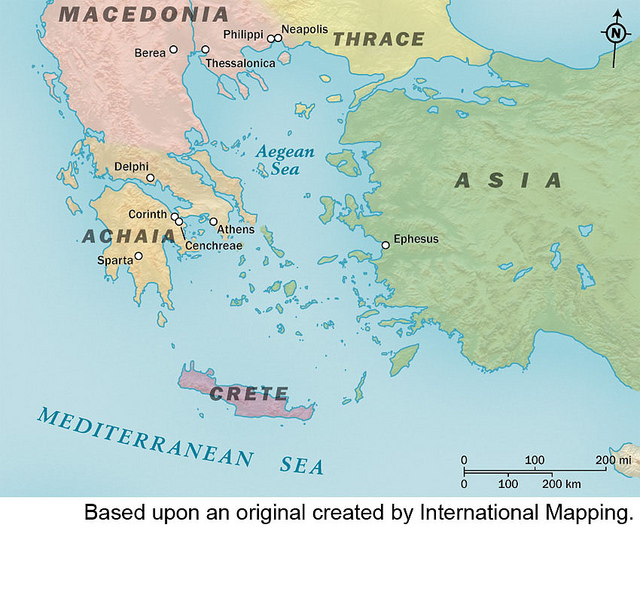Introducing the New Testament
A Historical, Literary, and Theological Survey
16. Ephesians
Chapter Intro Video
Chapter Objectives
This chapter should enable the student to
summarize what modern scholarship has to say regarding the historical background for Ephesians, including suppositions about the location to which this letter was addressed and its possible relationship to other Pauline letters.
discuss the question of whether Ephesians is an authentic or pseudepigraphical letter and indicate how a decision in this regard would affect conclusions regarding the letter’s date of composition and presumed audience.
describe the central theological themes of Ephesians with reference to the mysterious plan of God, the elevation of the church, and the idealized status of believers.
Chapter Summary
This chapter offers a brief overview of the content of Ephesians, followed by discussion of historical background and major themes.
In terms of historical background, the work is presented in modern New Testaments as a letter of Paul to believers in Ephesus. A good deal of information is available concerning this setting, where Paul worked extensively, and where the temple of Artemis was a revered wonder of the world. There is some evidence, however, to suggest that Ephesians may have been a “circular letter” sent to multiple locations. Many scholars, furthermore, believe the letter is a pseudepigraphical work written after Paul’s death. In any case, it has close parallels to Colossians and could have been fashioned either by Paul or by someone else to present a more generic version of what is said there.
The dominant theme of Ephesians seems to be that God’s plan to unite all things in Christ is being accomplished in two stages: first, the crucifixion of Jesus effected forgiveness of sins and, now, his exaltation to heaven allows him to eradicate the influence of hostile spiritual powers. Ephesians claims that the church has been elevated with Christ such that it evinces a divinely granted unity. Believers enjoy an idealized status that empowers them to triumph over forces of evil. In a more pragmatic vein, however, the letter also offers down-to-earth advice regarding family life, moral behavior, and protection from the devil.
Study Questions
What is known of the ancient city of Ephesus and Paul’s ministry there? Explain why this information may or may not be helpful for interpreting the New Testament letter to the Ephesians.
What two observations become evident when Ephesians is compared to other letters attributed to Paul? Based on these observations, what scenarios have scholars suggested regarding circumstances of the book’s composition?
Discuss the theme of “spiritual beings” evident in the letter to the Ephesians: what were these beings, what does this letter say has happened regarding them, and why does this matter for Christian believers?
What is the mysterious plan of God according to Ephesians and what is the primary sign that this plan has been or is being fulfilled?
What does the letter to the Ephesians have to say about the church? Cite at least three affirmations about the church that receive particular emphasis in this letter.
How is the “household code” contained in Ephesians 5:21–6:9 similar to such codes found in Greco-Roman literature in general? How does it differ from the codes found in those other writings?
Describe what Ephesians has to say regarding the current idealized state of believers and indicate why some scholars think this contradicts what Paul says in other letters. What would be a possible explanation for the discrepancy?
Gallery: The Armor of God
Gallery: The Ruins of Ephesus
Map: Pauline Cities around the Aegean Sea
Province of Achaia See Romans 15:26; 1 Corinthians 16:15; 2 Corinthians 1:1; 9:2; 11:10; 1 Thessalonians 1:7–8; cf. Acts 18:12; 19:21 Athens See 1 Thessalonians 3:1; cf. Acts 17:15–16; 18:1 Corinth See 1 Corinthians 1:2; 2 Corinthians 1:1, 23; cf. 2 Timothy 4:20; Acts 18:1 Province of Asia See Romans 16:5; 1 Corinthians 16:19; 2 Corinthians 1:8; cf. 2 Timothy 1:15; Acts 16:6; 19:10, 22, 26–27, 31; 20:4, 16, 18; 21:27; 24:19; 27:2 Colossae See Colossians 1:2 Ephesus See 1 Corinthians 15:32; 16:8; cf. Ephesians 1:1; 1 Timothy 1:3; 2 Timothy 1:18; 4:12; Acts 18:19, 21; 19:1, 17, 26; 20:16–17 Hierapolis See Colossians 4:13 Laodicea See Colossians 2:1; 4:13, 15–16 Troas See 2 Corinthians 2:12; cf. 2 Timothy 4:13; Acts 16:8, 11; 20:5–6 Province of Crete See Titus 1:5 Province of Macedonia See Romans 15:26; 1 Corinthians 16:5; 2 Corinthians 1:16; 2:13; 7:5; 8:1; 9:2; 11:9; Philippians 4:15; 1 Thessalonians 1:7–8; 4:10; cf. 1 Timothy 1:3; Acts 16:9–10, 12; 18:5; 19:21–22; 20:1, 3 Philippi See Philippians 1:1; 1 Thessalonians 2:2; cf. Acts 16:12; 20:6 Neapolis See Acts 16:11 Thessalonica See Phil. 4:16; 1 Thess. 1:1; cf. 2 Thess. 1:1; 2 Tim. 4:10; Acts 17:1, 11, 13; 20:4; 27:2
Assets
-
Hyperlink 16.1. Literary Siblings: Relationship of Ephesians to ColossiansDownload
-
Hyperlink 16.2. Authorship of EphesiansDownload
-
Hyperlink 16.3. A Life Worthy of the CallingDownload
-
Hyperlink 16.4. Ephesians in the Revised Common LectionaryDownload
-
Hyperlink 16.5. Bibliography: EphesiansDownload
-
Map 16.1. Pauline Cities around the Aegean SeaDownload
-
Box 16.1. Powerful Spiritual BeingsDownload
-
Box 16.2. Parallels between Ephesians and ColossiansDownload
-
Box 16.3. Distinctive Aspects of EphesiansDownload
-
Box 16.4. The Christian HouseholdDownload


